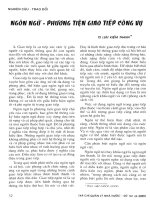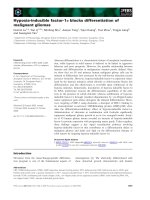Tài liệu Báo cáo khoa học: "Incorporating Context Information for the Extraction of Terms" pdf
Bạn đang xem bản rút gọn của tài liệu. Xem và tải ngay bản đầy đủ của tài liệu tại đây (254.76 KB, 3 trang )
Incorporating Context Information for the Extraction of Terms
Katerina T. Frantzi
Dept. of Computing
Manchester Metropolitan University
Manchester, M1 5GD, U.K.
K. Frantzi@doc. mmu. ac. uk
Abstract
The information used for the extraction of
terms can be considered as rather 'inter-
nal', i.e. coming from the candidate string
itself. This paper presents the incorpora-
tion of 'external' information derived from
the context of the candidate string. It
is embedded to the
C-value
approach for
automatic term recognition (ATR), in the
form of weights constructed from statisti-
cal characteristics of the context words of
the candidate string.
1 Introduction &: Related Work
The applications of term recognition (specialised dic-
tionary construction and maintenance, human and
machine translation, text categorization, etc.), and
the fact that new terms appear with high speed in
some domains (e.g. in computer science), enforce the
need for automating the extraction of terms. ATR
also gives the potential to work with large amounts
of real data, that it would not be able to handle man-
ually. We should note that by ATR we neither mean
dictionary string matching, nor term interpretation
(which deals with the relations between terms and
concepts).
Terms may consist of either one or more words.
When the aim is the extraction of single-word terms,
domain-dependent linguistic information (i.e. mor-
phology) is used (Ananiadou, 1994). Multi-word
ATR usually uses linguistic information in the form
of a grammar that mainly allows noun phrases or
compounds to be extracted as candidate terms:
(Bourigault, 1992) extracts maximal-length noun
phrases and their subgroups (depending on their
grammatical structure and position) as candidate
terms. (Dagan and Church, 1994), accept sequen-
cies of nouns, which give them high precision, but
not such a good recall as that of (Justeson and
Katz, 1995), which allow some prepositions (i.e. oj~
to be part of the extracted candidate terms. (Frantzi
and Ananiadou, 1996), stand between these two ap-
proaches, allowing the extracted compounds to con-
tain adjectives but no prepositions. (Daille et al.,
1994) also allow adjectives to be part of the two-
word English terms they extract.
From the above, only (Bourigault, 1992) does not
use any statistical information. (Justeson and Katz,
1995) and (Dagan and Church, 1994) use the fre-
quency of occurrence of the candidate string as a
measure of its likelihood to be a term. (Daille et al.,
1994) agree that frequency of occurrence "presents
the best histogram", but also suggest the likeli-
hood ratio for the extraction of two-word English
terms. (Frantzi and Ananiadou, 1996), besides the
frequency of occurrence, also consider the frequency
of the candidate string as a part of longer candidate
terms, as well as the number of these longer candi-
date terms it is found nested in.
In this paper, we extend
C-value,
the statisti-
cal measure proposed by (Frantzi and Ananiadou,
1996), incorporating information gained from the
textual context of the candidate term.
2
Context information
for terms
The idea of incorporating context information for
term extraction came from that "Extended term
units are different in type from extended word units
in that they cannot be freely modified" (Sager,
1978). Therefore, information from the modifiers
of the candidate strings could be used in the pro-
cedure of their evaluation as candidate terms. This
could be extended beyond adjective/noun modifica-
tion, to verbs that belong to the candidate string's
context. For example, the form
shows
of the verb
to
show
in medical domains, is very often followed by
a term, e.g.
shows a basal cell carcinoma.
There are
cases where the verbs that appear with terms can
even be domain independent, like the form
called
of
501
the verb
to call,
or the form
known
of the verb
to
know,
which are often involved in definitions in var-
ious areas, e.g.
is known as the singular existential
quantifier, is called the Cartesian product.
Since context carries information about terms it
should be involved in the procedure for their ex-
traction. We incorporate context information in the
form of weights constructed in a fully automatic way.
2.1 The Linguistic Part
The corpus is tagged, and a linguistic filter will only
accept specific part-of-speech sequencies. The choice
of the linguistic filter affects the precision and re-
call of the results: having a 'closed' filter, that is,
a strict one regarding the part-of-speech sequencies
it accepts, like the N + that (Dagan and Church,
1994) use, wilt improve the precision but have bad
effect on the recall. On the other side, an 'open'
filter, one that accepts more part-of-speech sequen-
cies, like that of (Justeson and Katz, 1995) that ac-
cepts prepositions as well as adjectives and nouns,
will have the opposite result.
In our choice of the linguistic filter, we lie some-
where in the middle, accepting strings consisting of
adjectives and nouns:
( N ounlAdjective) + Noun
(1)
However, we do not claim that this specific fil-
ter should be used at all cases, but that its choice
depends on the application: the construction of
domain-specific dictionaries requires high coverage,
and would therefore allow low precision in order to
achieve high recall, while when speed is required,
high quality would be better appreciated, so that
the manual filtering of the extracted list of candidate
terms can be as fast as possible. So, in the first case
we could choose an 'open' linguistic filter (e.g. one
that accepts prepositions), while in the second, a
'closed' one (e.g. one that only accepts nouns).
The type of context involved on the extraction
of candidate terms is also an issue. At this stage
of this work, the adjectives, nouns and verbs are
considered. However, further investigation is needed
over the context used (as it is discussed in the future
work).
2.2 The Statistical Part
The procedure involves the following steps:
Step 1:
The raw corpus is tagged and from
the tagged corpus the strings that obey the
(NounlAdjective)+Noun
expression are extracted.
Step 2:
For these strings,
C-value
is calculated
resulting in a list of candidate terms (ranked by C-
value as
their likelihood of being terms). The length
of the string is incorporated in the
C-value
measure
resulting to
C-value'
C-value' (a) -=- I
where
log2 lalf(a)
lal
= max,
~,~,
~(b)
log2
lal(f(a) - p(ro) )
otherwise
(2)
a is the examined string,
lal the length of a in terms of number of words,
f(a)
the frequency of a in the corpus,
Ta the set of candidate terms that contain a,
P(T~)
the number of these candidate terms.
At this point the incorporation of the context in-
formation will take place.
Step 3:
Since
C-value
is a measure for extract-
ing terms, the top of the previously constructed list
presents the higher density on terms among any
other part of the list. This top of the list, or else,
the 'first' of these ranked candidate terms will give
the weights to the context. We take the top ranked
candidate strings, and from the initial corpus we ex-
tract their context which currently are the adjec-
tives, nouns and verbs that surround the candidate
term. For each of these adjectives, nouns and verbs,
we consider three parameters:
1. its total frequency in the corpus,
2. its frequency as a context word (of the 'first'
candidate terms),
3. the number of these 'first' candidate terms it
appears with.
These characteristics are combined in the following
way to assign a weight to the context word
ft(w) )
Weight(w) =
0.5(~ -~ +
f(w)
(3)
where
w is the noun/verb/adjective to be assigned a
weight,
n the number of the 'first' candidate terms consid-
ered,
t(w)
the number of candidate terms the word w ap-
pears with,
ft(w) w's
total frequency appearing with candidate
terms,
f(w) w's
total frequency in the corpus.
A variation to improve the results, that involves
human interaction, is the following: the candidate
terms involved for the extraction of context are
firstly manually evaluated, and only the 'real terms'
will proceed to the extraction of the context and as-
signment of weights (as previously).
502
At this point a list of context words together with
their weights has been created.
Step 4: The previously created by C-value r list will
now be re-ordered considering the weights obtained
from step 3. For each of the candidate strings of the
list. its context (adjectives, nouns and verbs that
surround it) are extracted from the corpus. These
context words have either been found at step 3 and
therefore assigned a weight, or not. In the latter
case, they are now assigned weight equal to 0.
Each of these candidate strings is now ready to be
assigned a context weight which would be the sum
of the weights of its context words:
wei(a) = Weight(b) + 1
(4)
b~C°
where
a is the examined n-gram,
Ca the context of a,
Weight(b) the calculated (from step 3) weight for
the word b.
The candidate terms will be now re-ranked according
to:
1
NC.value(a) = ~ C-value'(a) • wei(a) (5)
tog(. r)
where
a is the examined n-gram,
C-value'(a) calculated from step 2,
wei(a), the calculated from step 4 sum of the context
weights for a,
N the size of the corpus in terms of number of words.
3 Future work
Our future work involves
1. The investigation of the context used for the
evaluation of the candidate string, and the amount
of information that various context carries. We said
that for this prototype we considered the adjectives,
nouns and verbs that surround the candidate string.
However, could ~something else' also carry useful in-
formation? Should adjectives, nouns and verbs all
be considered to carry the same amount of informa-
tion, or should they be assigned different weights?
2. The investigation of the assignment of weights
on the parameters used for the measures. Currently,
the measures contain the parameters in a 'flat' way.
That is, not really considering the 'weight' (the im-
portance) of each of them. So, the measures are at
this point a description of which parameters to be
used, and not on the degree to which they should be
used.
3. The comparison of this method with other ATR
approaches. The experimentation on real data will
show if this approach actually brings improvement to
the results in comparison with previous approaches.
Moreover, the application on real data should cover
more than one domains.
4 Acknowledgement
I thank my supervisors Dr. S. Ananiadou and
Prof. J. Tsujii. Also Dr. T. Sharpe from the Med-
ical School of the University of Manchester for the
eye-pathology corpus.
References
Sophia Ananiadou. 1988. A Methodology for Auto-
matic Term Recognition. Ph.D Thesis, University
of Manchester Institute of Science and Technol-
ogy.
Didier Bourigault. 1992. Surface Grammatical
Analysis for the Extraction of Terminological
Noun Phrases. In Proceedings of the Interna-
tional Conference on Computational Linguistics,
COLING-92, pages 977-981.
Ido Dagan and Ken Church. 1994. Termight: Iden-
tifying and Translating Technical Terminology. In
Proceedings of the European Chapter of the Asso-
ciation for Computational Linguistics, EACL-94,
pages 34-40.
B~atrice Daille, I~ric Gaussier and Jean-Marc Lang,.
1994. Towards Automatic Extraction of Monolin-
gual and Bilingual Terminology. In Proceedings
of the International Conference on Computational
Linguistics, COLING-94, pages 515-521.
Katerina T. Frantzi and Sophia Ananiadou. 1996.
A Hybrid Approach to Term Recognition. In Pro-
ceedings of the International Conference on Nat-
ural Language Processing and Industrial Applica-
tions, NLP+L4-96. pages 93-98.
John S. Justeson and Slava M. Katz. 1995. Tech-
nical terminology: some linguistic properties and
an algorithm for identification in text. In Natural
Language Engineering, 1:9-27.
Juan C. Sager. 1978. Commentary in Table Ronde
sur les Probldmes du Ddcourage du Terme. Ser-
vice des Publications, Direction des Francaise,
Montreal, 1979, pages 39-52.
503









